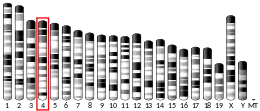GPR3
G-protein coupled receptor 3 is a protein that in humans is encoded by the GPR3 gene.[5][6] The protein encoded by this gene is a member of the G protein-coupled receptor family of transmembrane receptors and is involved in signal transduction.
Function
GPR3 activates adenylate cyclase in the absence of ligand.[7] GPR3 is expressed in mammalian oocytes where it maintains meiotic arrest and is thought to be a communication link between oocytes and the surrounding somatic tissue.[8] It has been proposed that sphingosine 1-phosphate (S1P) and sphingosylphosphorylcholine (SPC) are GPR3 ligands,[9][10] however this result was not confirmed in a β-arrestin recruitment assay.[11]
Mice lacking GPR3 were found to develop late-onset obesity owing to decreased UCP-1 expression in brown adipose tissue and reduced thermogenic capacity.[12]
References
- GRCh38: Ensembl release 89: ENSG00000181773 - Ensembl, May 2017
- GRCm38: Ensembl release 89: ENSMUSG00000049649 - Ensembl, May 2017
- "Human PubMed Reference:". National Center for Biotechnology Information, U.S. National Library of Medicine.
- "Mouse PubMed Reference:". National Center for Biotechnology Information, U.S. National Library of Medicine.
- Marchese A, Docherty JM, Nguyen T, Heiber M, Cheng R, Heng HH, Tsui LC, Shi X, George SR, O'Dowd BF (Mar 1995). "Cloning of human genes encoding novel G protein-coupled receptors". Genomics. 23 (3): 609–18. doi:10.1006/geno.1994.1549. PMID 7851889.
- "Entrez Gene: GPR3 G protein-coupled receptor 3".
- Eggerickx D, Denef JF, Labbe O, Hayashi Y, Refetoff S, Vassart G, Parmentier M, Libert F (August 1995). "Molecular cloning of an orphan G-protein-coupled receptor that constitutively activates adenylate cyclase". Biochem. J. 309 (Pt 3): 837–43. doi:10.1042/bj3090837. PMC 1135708. PMID 7639700.
- Mehlmann LM, Saeki Y, Tanaka S, Brennan TJ, Evsikov AV, Pendola FL, Knowles BB, Eppig JJ, Jaffe LA (December 2004). "The Gs-linked receptor GPR3 maintains meiotic arrest in mammalian oocytes". Science. 306 (5703): 1947–50. Bibcode:2004Sci...306.1947M. doi:10.1126/science.1103974. PMID 15591206. S2CID 37342089.
- Uhlenbrock K, Gassenhuber H, Kostenis E (November 2002). "Sphingosine 1-phosphate is a ligand of the human gpr3, gpr6 and gpr12 family of constitutively active G protein-coupled receptors". Cell. Signal. 14 (11): 941–53. doi:10.1016/S0898-6568(02)00041-4. PMID 12220620.
- Hinckley M, Vaccari S, Horner K, Chen R, Conti M (November 2005). "The G-protein-coupled receptors GPR3 and GPR12 are involved in cAMP signaling and maintenance of meiotic arrest in rodent oocytes". Dev. Biol. 287 (2): 249–61. doi:10.1016/j.ydbio.2005.08.019. PMID 16229830.
- Yin H, Chu A, Li W, Wang B, Shelton F, Otero F, Nguyen DG, Caldwell JS, Chen YA (May 2009). "Lipid G Protein-coupled Receptor Ligand Identification Using β-Arrestin PathHunter™ Assay". J. Biol. Chem. 284 (18): 12328–38. doi:10.1074/jbc.M806516200. PMC 2673301. PMID 19286662.
- Godlewski, Grzegorz; Jourdan, Tony; Szanda, Gergő; Tam, Joseph; Cinar, Resat; Harvey-White, Judith; Liu, Jie; Mukhopadhyay, Bani; Pacher, Pál; Ming Mo, Fong; Osei-Hyiaman, Douglas (2015-10-12). "Mice lacking GPR3 receptors display late-onset obese phenotype due to impaired thermogenic function in brown adipose tissue". Scientific Reports. 5: 14953. Bibcode:2015NatSR...514953G. doi:10.1038/srep14953. ISSN 2045-2322. PMC 4601089. PMID 26455425.
Further reading
- Eggerickx D, Denef JF, Labbe O, et al. (1995). "Molecular cloning of an orphan G-protein-coupled receptor that constitutively activates adenylate cyclase". Biochem. J. 309 (Pt 3): 837–43. doi:10.1042/bj3090837. PMC 1135708. PMID 7639700.
- Iismaa TP, Kiefer J, Liu ML, et al. (1995). "Isolation and chromosomal localization of a novel human G-protein-coupled receptor (GPR3) expressed predominantly in the central nervous system". Genomics. 24 (2): 391–4. doi:10.1006/geno.1994.1635. PMID 7698767.
- Heiber M, Docherty JM, Shah G, et al. (1995). "Isolation of three novel human genes encoding G protein-coupled receptors". DNA Cell Biol. 14 (1): 25–35. doi:10.1089/dna.1995.14.25. PMID 7832990.
- Song ZH, Modi W, Bonner TI (1996). "Molecular cloning and chromosomal localization of human genes encoding three closely related G protein-coupled receptors". Genomics. 28 (2): 347–9. doi:10.1006/geno.1995.1154. PMID 8530049.
- Strausberg RL, Feingold EA, Grouse LH, et al. (2003). "Generation and initial analysis of more than 15,000 full-length human and mouse cDNA sequences". Proc. Natl. Acad. Sci. U.S.A. 99 (26): 16899–903. Bibcode:2002PNAS...9916899M. doi:10.1073/pnas.242603899. PMC 139241. PMID 12477932.
- Uhlenbrock K, Huber J, Ardati A, et al. (2003). "Fluid shear stress differentially regulates gpr3, gpr6, and gpr12 expression in human umbilical vein endothelial cells". Cell. Physiol. Biochem. 13 (2): 75–84. doi:10.1159/000070251. PMID 12649592. S2CID 45156405.
- Gerhard DS, Wagner L, Feingold EA, et al. (2004). "The Status, Quality, and Expansion of the NIH Full-Length cDNA Project: The Mammalian Gene Collection (MGC)". Genome Res. 14 (10B): 2121–7. doi:10.1101/gr.2596504. PMC 528928. PMID 15489334.
- Gregory SG, Barlow KF, McLay KE, et al. (2006). "The DNA sequence and biological annotation of human chromosome 1". Nature. 441 (7091): 315–21. Bibcode:2006Natur.441..315G. doi:10.1038/nature04727. PMID 16710414.




